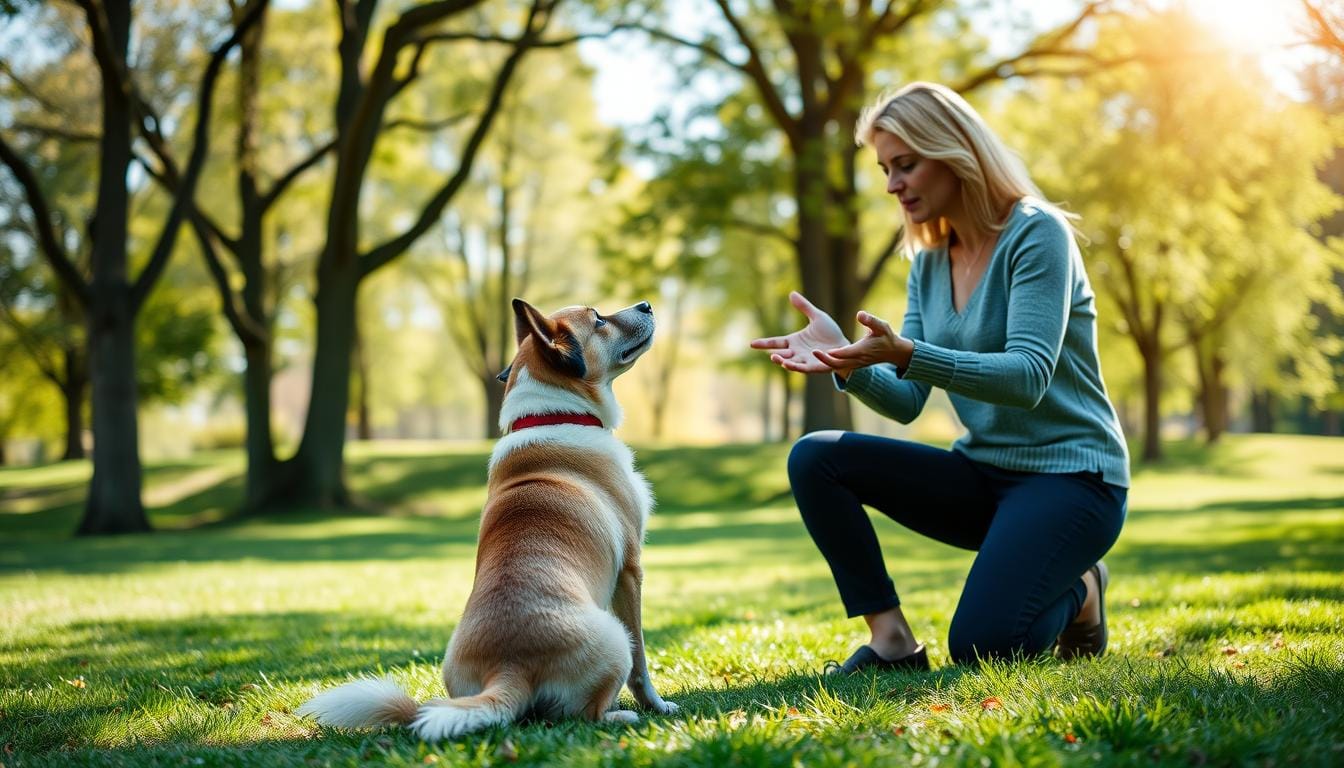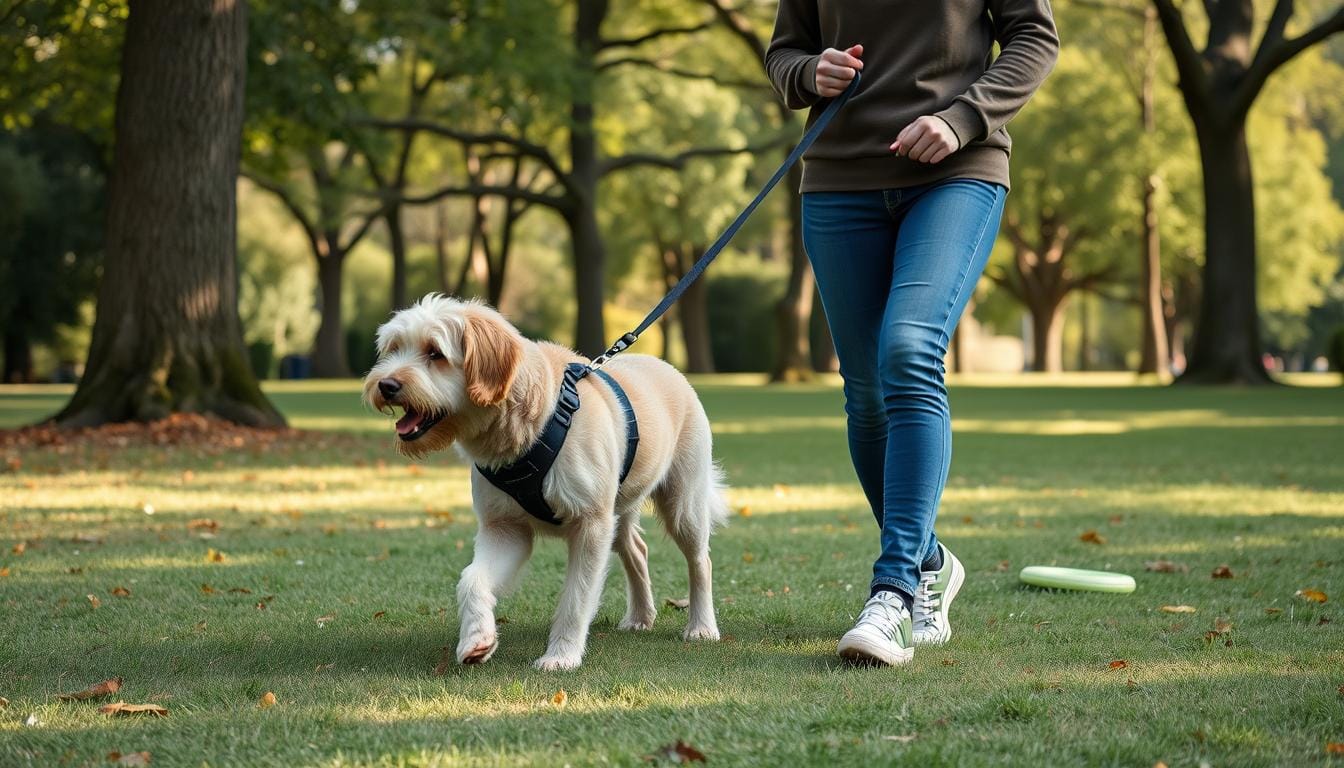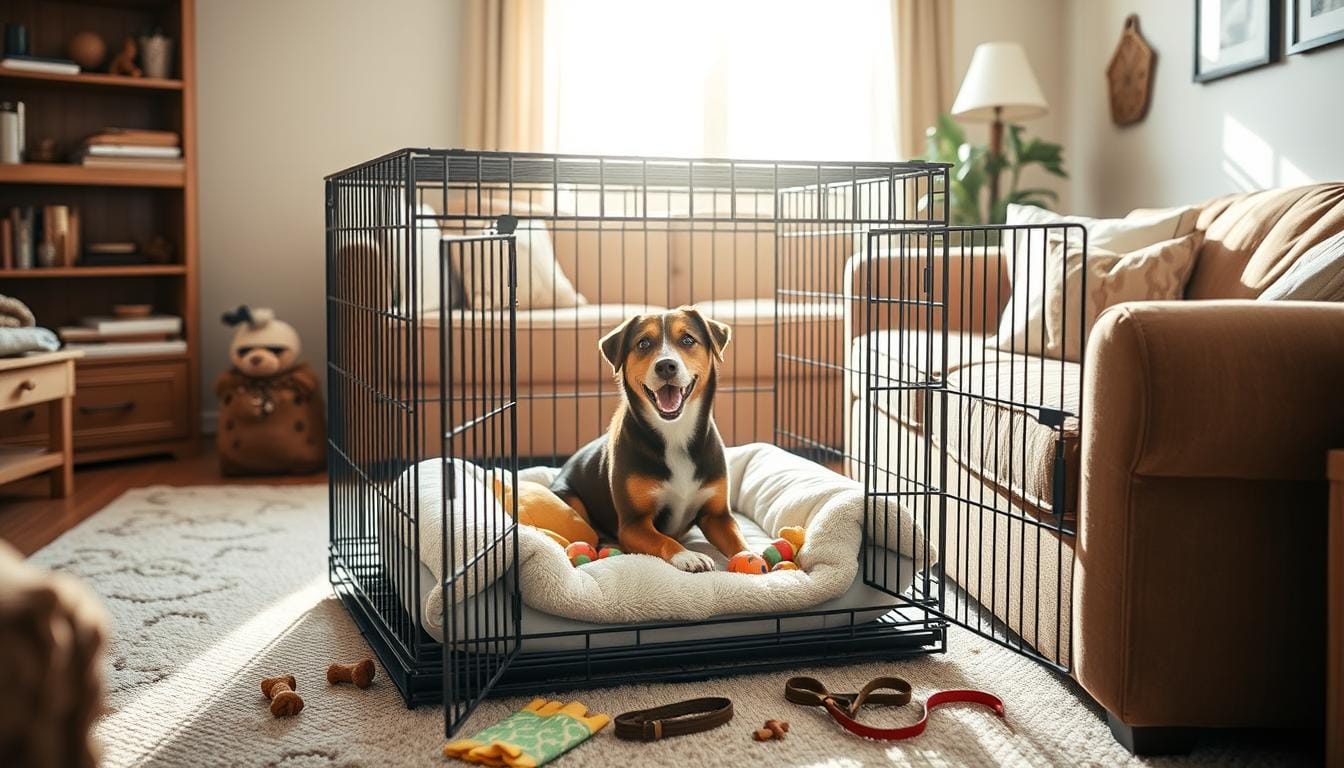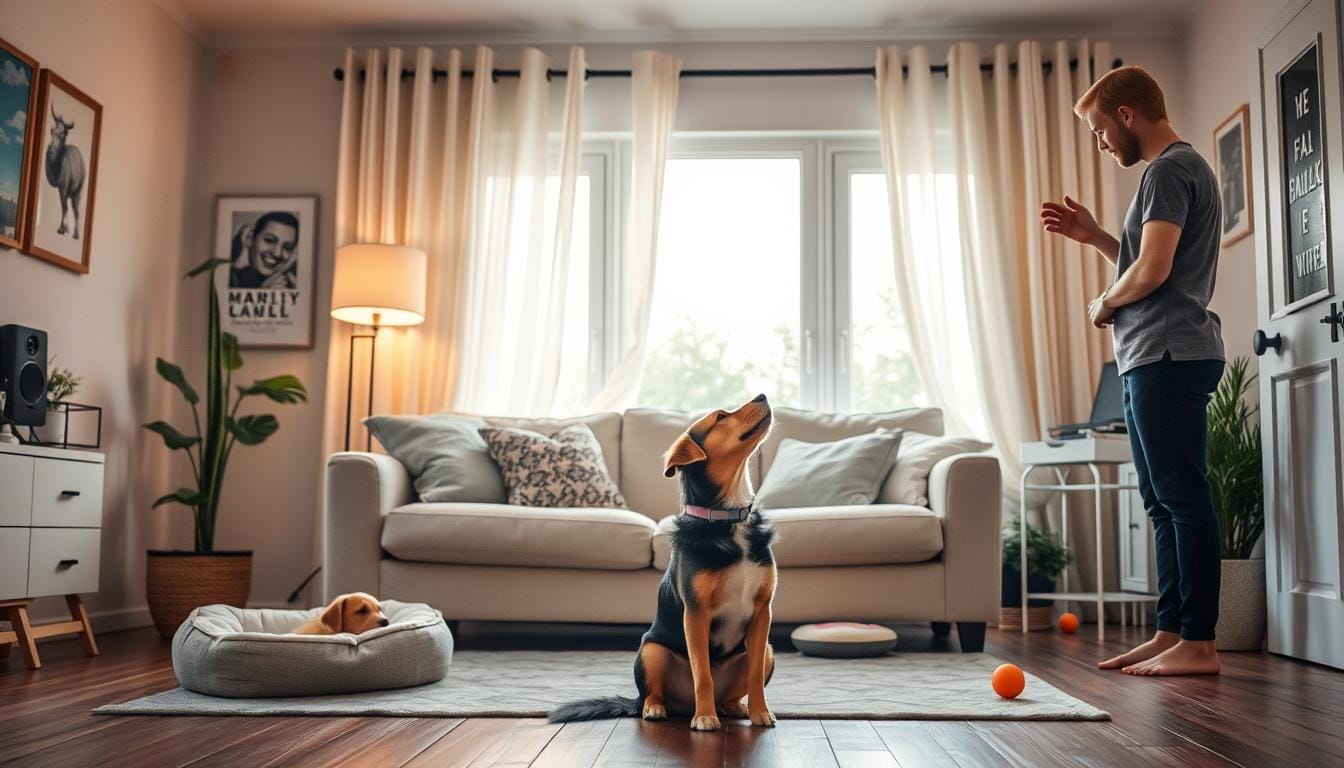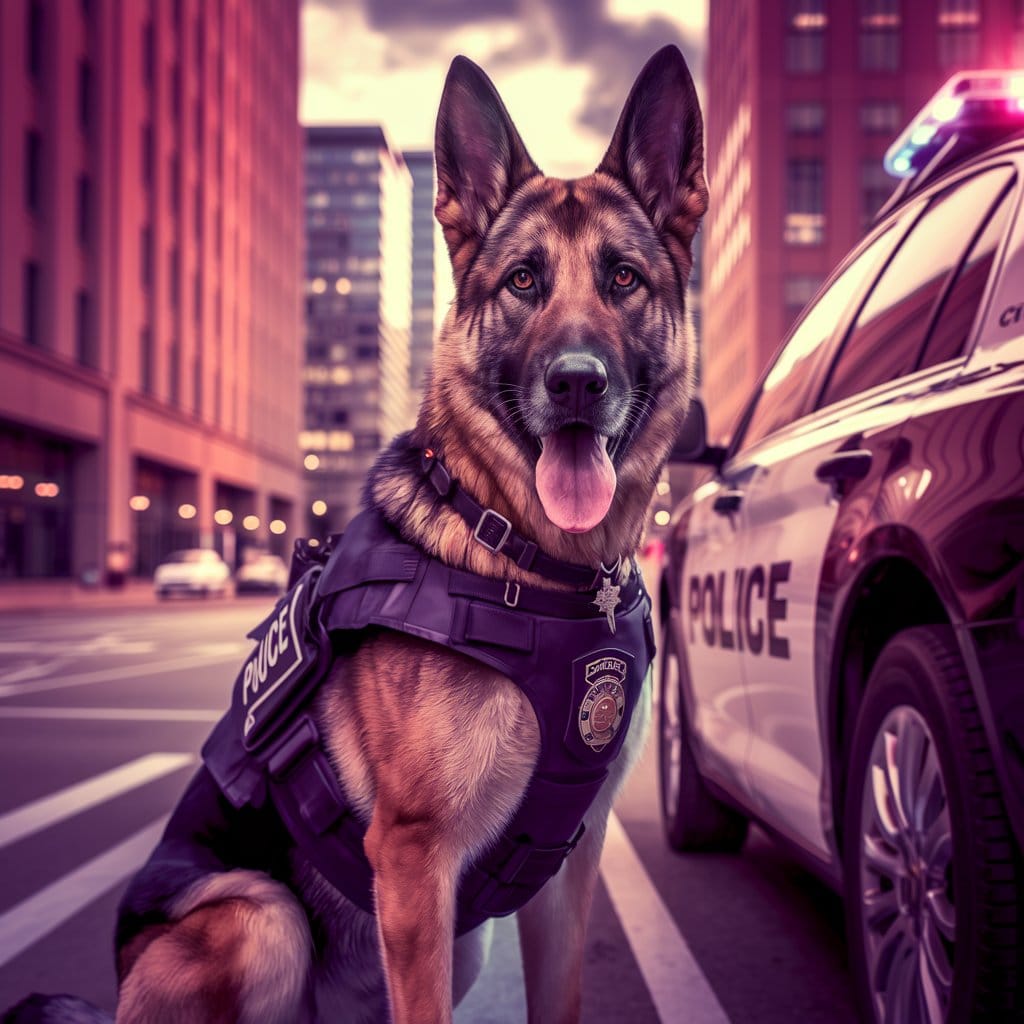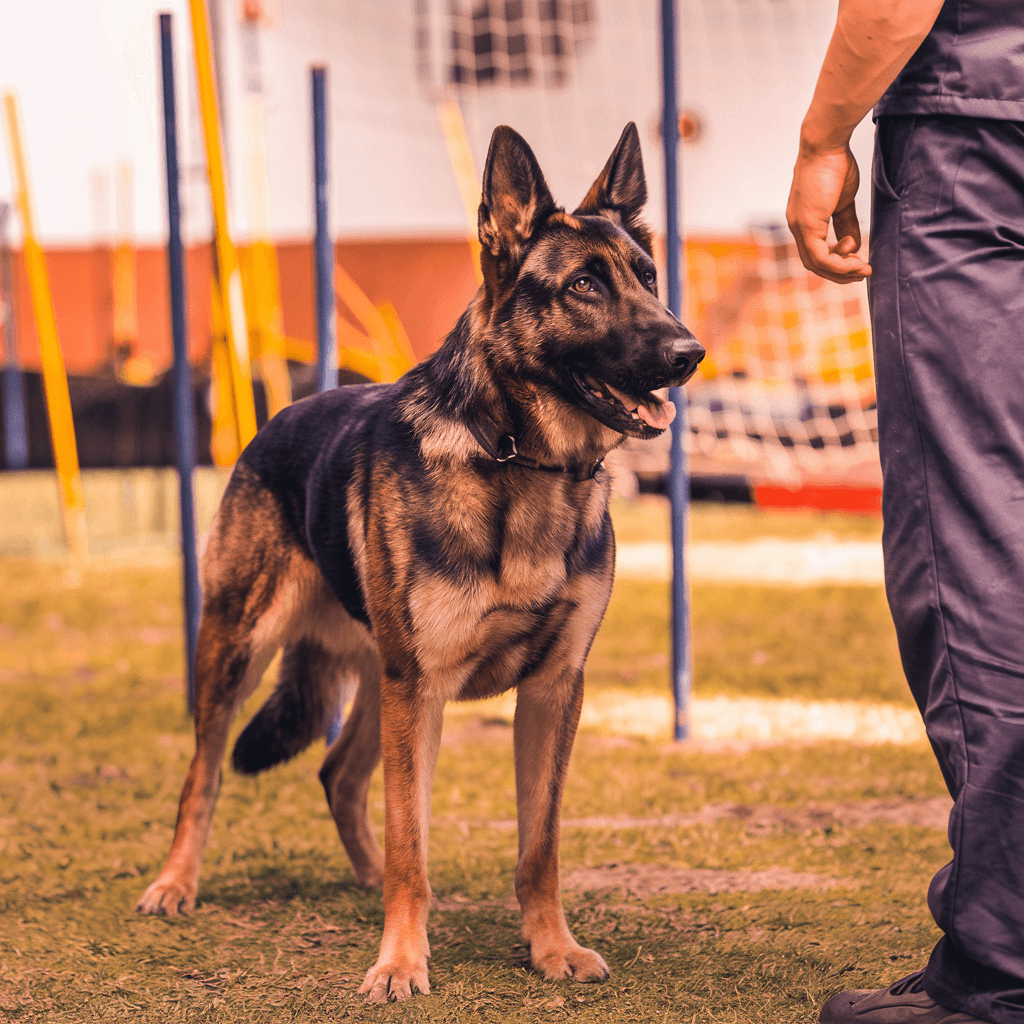Ready to unlock your dog’s potential? We’re about to dive into the world of dog training commands. These commands will transform your furry friend into an obedient companion. They’re not just tricks; they’re essential for a safer, happier life for you and your pup.
From the foundational “sit” to the life-saving “come,” we’ll explore pet training tips that work wonders. Whether you’re dealing with a playful puppy or an older dog, these obedience skills are crucial for every canine.
Did you know that 95% of dog owners find the “come” command essential for managing their dog’s behavior? Or that 85% of dogs respond well to the “leave it” command, preventing them from picking up potentially harmful objects? These statistics highlight just how important proper training can be.
We’ll guide you through each command, explaining why it’s important and how to teach it effectively. By the end of this guide, you’ll have the knowledge to start transforming your dog into a well-behaved member of the family.
Key Takeaways
- The “sit” command is foundational, used by 95% of trainers to manage unwanted behaviors
- 90% of dogs respond positively to emergency recall commands
- 80% of trainers emphasize the importance of the “watch me” command
- 70% of trainers recommend the “stay” command for public and private settings
- Positive reinforcement is key in effective dog training
- Consistency in command phrases helps dogs understand instructions better
- Early training, starting from 8 weeks old, can lead to better results
Understanding the Importance of Basic Dog Training
Basic dog training is key to a well-behaved and happy dog. By spending time on puppy training and obedience classes, we prepare our dogs for many situations. It’s important for both dogs and their owners to master these skills.
Benefits of Training Your Dog
Training your dog is more than teaching tricks. It builds a strong bond between you and your pet. Trained dogs are easier to handle, less likely to have bad behaviors, and adapt well to new places.
Obedience classes can solve problems like too much barking or jumping on visitors. This makes life better for everyone.
Building Trust and Communication
Positive reinforcement helps build a strong bond with our dogs. Training sessions are great for spending quality time together. As dogs learn commands like “sit,” “stay,” and “come,” they gain confidence and trust in their owners.
This better communication makes our relationship more fulfilling.
Safety and Control Advantages
Basic obedience commands are vital for our dogs’ safety. A reliable recall can prevent dangerous situations. Commands like “leave it” and “drop it” stop dogs from eating harmful things.
Training also helps manage your dog in public, making outings better for everyone.
- Start training early, ideally around 8 weeks old
- Keep sessions short, 5-10 minutes, 2-3 times daily
- Use high-value treats for positive reinforcement
- Practice in different locations to generalize skills
- Gradually introduce distractions during training
By committing to basic dog training, we ensure a lifetime of good behavior and a strong bond. Whether through professional classes or home training, the effort is worth it. It makes our dogs well-mannered and happy.
Dog Training Commands, Basic Commands, Obedient Dogs, Pet Training Tips
Training your dog needs patience, consistency, and the right methods. We’ll look at positive reinforcement, essential tools, and a training plan. This will help you raise a well-behaved dog.
Positive Reinforcement Methods
Positive reinforcement is key in dog training. It rewards good behavior, making your dog want to do it again. Clicker training uses a sound to mark correct actions instantly.
Using treats is helpful, but choose small ones to avoid overfeeding. Praise and affection are also great rewards.
Training Equipment Essentials
To start training, you’ll need a few things:
- Small, high-value treats
- Clicker for clicker training
- Short and long leashes for different training scenarios
- Comfortable collar or harness

Creating a Training Schedule
Consistency is key in dog training. A regular routine helps your dog learn faster and remember commands better. Here’s a sample schedule:
| Time | Activity | Duration |
|---|---|---|
| Morning | Basic obedience (Sit, Stay, Come) | 10-15 minutes |
| Afternoon | Recall training outdoors | 10-15 minutes |
| Evening | New command introduction | 5-10 minutes |
Keep training sessions short, about 15 minutes, to keep your dog focused. Start in a quiet place and add distractions as your dog gets better. Repeating commands helps your dog connect actions with words.
For more advanced training, consider obedience classes. These classes can improve your home training and give your dog social time.
The “Sit” Command: Foundation of Obedience
The “sit” command is a key part of dog training. It’s the first step for many other commands. It helps build a strong obedience foundation. Over 90% of dog owners say it’s essential for a well-behaved pet.
Step-by-Step Training Process
To teach the sit command, we use positive reinforcement. Here’s how to do it:
- Hold a treat close to your dog’s nose
- Slowly move the treat up and back over their head
- As your dog follows the treat, their bottom will lower
- Once they’re in a sitting position, say “sit” and give the treat
- Repeat this process, gradually phasing out the hand motion
Common Training Mistakes
Avoid these mistakes when teaching the sit command:
- Moving the treat too quickly
- Saying “sit” before your dog is in position
- Inconsistent reinforcement
- Training for too long in one session
Reinforcement Techniques
Consistency is key in reinforcing the sit command. Start with treats, then use praise and petting. Practice in different places to make the behavior stick.
| Training Stage | Reinforcement Method | Frequency |
|---|---|---|
| Initial Learning | Treats + Praise | Every successful sit |
| Intermediate | Intermittent Treats + Praise | Every 2-3 successful sits |
| Advanced | Mostly Praise, Occasional Treats | Random reinforcement |
Remember, patience and consistency are vital. With regular practice, your dog will master this fundamental command. This will open the door to more advanced training.
Teaching the “Stay” Command
The “stay” command is key for obedient dogs. We start by having the dog sit, then take a step back and say “stay”. If they stay still, we reward them. This builds trust and encourages good behavior.
For effective pet training, short sessions of 15 to 30 minutes daily are best. Start with short intervals and gradually increase them. Experts say to add 3 to 5 seconds between the sit command and reward with each repetition.
Safety is crucial when teaching “stay”. Avoid places like busy streets or leaving your dog alone in a park. Instead, use “The Cornered Stay” technique. It limits escape routes and helps dogs focus.
- Start with 6 feet for 6 seconds
- Progress to 10 feet for 10 seconds
- Use hand signals and blocking movements
- Incorporate treats as high-value rewards
To reinforce the command, use visual aids like drawing an octagon to show eliminated running directions. If your dog breaks the stay, a gentle finger poke or foot stomp can redirect their attention.
“The ‘stay’ command has been a lifesaver for my energetic pup. It’s prevented countless dangerous situations.”
Remember, mastering “stay” takes time. Make sure your dog is proficient at each stage before advancing. With patience and consistency, you’ll have a well-trained companion ready for any situation.
Mastering the “Come” Command for Reliable Recall
The “come” command is key for your dog’s safety and control. A good recall means your dog will come back almost every time. This skill is vital for playing outside without a leash.
Distance Training Tips
Begin with short distances and then get longer. Use a 30′-50′ cotton web leash for safe training. Make the recall command fun and rewarding. Treats like chicken, cheese, or beef liver are great rewards.
Outdoor Training Strategies
Train in different places to make recall strong. Play games like “Catch Me” and “Find Me”. Aim for 15-20 minutes of training each day. It takes about 1-2 months of regular training to get it right.
Dealing with Distractions
Slowly add distractions to training. Always praise your dog for coming back. If they don’t come, try luring them. Some trainers use e-collars, but it’s a topic of debate.
| Training Element | Recommendation |
|---|---|
| Training Duration | 15-20 minutes daily |
| Time to Reliability | 1-2 months of consistent practice |
| Best Treats | Chicken, cheese, beef liver |
| Training Games | “Catch Me”, “Find Me” |
| Training Leash | 30′-50′ cotton web |
Getting a solid recall command takes patience and regular practice. With effort, you’ll get your dog to come back reliably. This ensures your dog’s safety and your peace of mind.
The “Down” Command and Its Applications
Teaching the “Down” command is key for obedient dogs. It helps manage their energy and promotes calm in different situations. Mastering “Down” stops jumping and other excited behaviors, which is great for vet visits or when you have guests.
To start, pick a quiet spot and make sure your dog is hungry. Use a 6-foot leash and their favorite treats as rewards. Being consistent is crucial in teaching this command.
Begin by luring your dog into a sitting position. Then, slowly lower the treat to the ground. Say “Down” as they follow, rewarding them when their belly touches the floor.

Keep practicing this several times, then start to reduce the lure. After a few days, try training without the leash. Always stay calm and praise your dog. As they get better, practice in busier places to help them understand the command better.
“The ‘Down’ command lays the groundwork for more advanced training exercises by teaching dogs to stay in one position until released.”
In places like crowded parks or family gatherings, a reliable “Down” command is crucial. It keeps your dog calm and prevents over-excitement. Professional trainers can help you master this command and address any behavioral issues.
| Training Tips | Benefits |
|---|---|
| Use positive reinforcement | Improves impulse control |
| Practice in various locations | Enhances obedience in different scenarios |
| Gradually increase duration | Builds patience and focus |
| Incorporate distractions | Strengthens reliability of the command |
“Leave It” and “Drop It” Commands for Safety
Teaching your dog “leave it” and “drop it” is key for their safety. These tips help stop them from picking up harmful items. They also make sure they let go of things they already have.
Prevention vs. Response Commands
“Leave it” stops them from getting something dangerous. “Drop it” is for when they already have something they shouldn’t.
Real-world Applications
These commands are super useful every day. Use “leave it” when they see something bad on walks. “Drop it” is good if they pick up something they shouldn’t.
Training Progression
Begin with small treats for “leave it” training. Show the treat, then close your hand. Reward with a bigger treat when they stop trying to get it. For “drop it,” swap toys or treats.
| Command | Training Steps | Recommended Situations |
|---|---|---|
| Leave It | 6 | 3 |
| Drop It | 3 | Various |
Training should be short, 5-10 minutes. Make it harder by adding time, distance, and distractions. Always be consistent and positive to teach these important safety commands.
Teaching “Heel” for Controlled Walking
Teaching your dog to heel is key in leash training. It makes walks fun for both of you. We’ll show you how to train your dog to heel well.
Begin by standing on your left side with your dog. Use treats to guide them into the right spot while walking. Reward them right away if they stay in place. Then, increase the walk distance and add distractions to help them learn.
Being consistent is important for obedient dogs. Keep training short but do it often. Use a loose leash to help them learn. The goal is for your dog to walk beside you without pulling or lagging.
“Heeling is one of the most common reasons a handler loses their prize in the NAVHDA testing system.”
To improve heel training:
- Use high-value treats to keep their focus
- Practice in different places
- Add verbal commands and hand signals
- Reward them sometimes to keep the good behavior
With patience and regular practice, your dog will learn the heel command. This will make your walks safer and more fun. Remember, a well-trained dog is a happy dog!
The “Watch Me” Command for Focus Training
Teaching your dog the “Watch Me” command is a game-changer in pet training. This basic command helps build a strong bond and improves focus during training sessions. Let’s explore how to master this essential skill.
Building Attention Span
Start in a quiet place where you’re the most interesting thing to your dog. Use a treat to lure their gaze to your face. When they make eye contact, immediately mark the behavior with a click or a “yes,” and reward them. Repeat this process, gradually increasing the duration of eye contact.
Keep training sessions under 10 minutes to maintain your dog’s interest. As your furry friend improves, practice in more distracting environments. This helps generalize the skill and strengthens their ability to focus on you in various situations.
Advanced Focus Exercises
Once your dog masters the basics, try these advanced pet training tips:
- Reward spontaneous eye contact
- Practice with distractions present
- Increase distance between you and your dog
- Combine “Watch Me” with other commands
Remember, consistency is key. Reinforce the “Watch Me” command regularly, and you’ll soon have a dog that’s attentive and responsive in any situation. This focus will make teaching other basic commands much easier, setting a strong foundation for all your future training endeavors.
Crate and Leash Training Fundamentals
Crate and leash training are key parts of puppy training and obedience classes. They help a dog behave well and strengthen the bond between dog and owner.
Creating Positive Associations
Crate training gives dogs a safe place and is handy for travel. We introduce the crate slowly, using treats and toys to make it a positive space. This way, puppies see their crate as a cozy den, not a punishment.
Progressive Training Steps
We start crate training with short times and then increase it. Leash training begins with short, positive experiences, rewarding calm behavior. We use treats and praise to teach good actions.
Troubleshooting Common Issues
Pulling on the leash is a common problem. We solve it with consistent training and positive rewards. For crate training, we ignore whining or barking and make sure the dog’s needs are met before putting them in the crate.
Remember, patience is crucial in puppy training. A study found that consistent training cuts unwanted behavior by 30% in a month. Short, frequent sessions of 5-10 minutes, 2-3 times a day, work best in obedience classes.
Conclusion
We’ve looked at the top 10 dog training commands every dog should know. These skills help dogs behave well and make a happy home for pets and owners. Using these tips, you’ll see your dog’s behavior improve and your bond grow stronger.
Training dogs needs patience, consistency, and positive feedback. Short, fun training sessions are best because dogs get bored easily. Always end on a positive note and add new commands slowly to keep your dog happy.
Teaching your dog to obey has many benefits. It keeps them mentally sharp, stops bad behavior, and makes them healthier. A well-trained dog is safer and has a better relationship with you. Spending time on these commands means a lifetime of trust and understanding with your dog.

